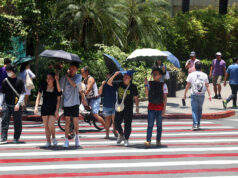NEDA bullish on project completion
THE GOVERNMENT now expects to complete nearly half of its 75 flagship infrastructure projects by the time President Rodrigo R. Duterte ends his six-year term due to efforts to address bottlenecks in approval, funding and implementation, the National Economic and Development Authority (NEDA) said in a briefing on Wednesday.
A summary presented to reporters showed that assessment in May put the number of projects to be completed by 2022 at 32 — cumulatively worth some P859.824 billion out of the P1.879-trillion total — compared to 26 as of June 2017.
Sixteen of the 32 have secured the final green light to proceed to procurement stage from the NEDA Board, which Mr. Duterte heads as chairman, 11 await approval by NEDA’s Investment Coordination Committee and then the NEDA Board, while five others are in earlier stages of the approval process.
The remaining 43 of the 75 projects — cumulatively worth some P1.019 trillion — are now expected to be completed beyond 2022.
SOME DELAYS IN ODA
“We have more projects expected to be completed by 2022…” Jonathan L. Uy, assistant secretary for investment programming, said in the briefing at the NEDA headquarters in Pasig City.
“This is part of the Project, Facilitation, Monitoring and Innovation Task Force in terms of accelerating the implementation of these projects, and refining the design and implementation plan in order to ensure that more of these projects will be completed by 2022,” Mr. Uy added.
“The directive now of the economic managers is to accelerate as much as possible.”
Socioeconomic Planning Secretary Ernesto M. Pernia said in the same briefing: “We must keep the infrastructure momentum and make sure there are no delays.”
“The NEDA Board has approved projects at a quicker pace while ascertaining their technical, financial, economic and social merits,” Mr. Pernia noted.
“We are determined to close the infrastructure gap.”
At the same time, Mr. Pernia cited delays in some projects funded by official development assistance (ODA).
“There’s also a lot of red tape on the side of ODA [donor-] countries. We thought that things would move fast, but they are not moving as fast as we expected,” he said.
“We cannot define what’s taking so long in ODA [donor] countries. They have their own bureaucracy in the approval process. It’s just in certain countries — like here — there are bureaucracies,” Mr. Pernia added.
He said the government is prepared to shift to other financing modes if ODA projects continue to be stalled.
“We were also discussing among ourselves, that if there are too many delays from a particular funding source, we are going to give them a deadline,” Mr. Pernia explained.
“So if they cannot fulfill the commitment in terms of time, then we will shift to another funding source.”
To recall, the administration prefers to finance its projects via state funds and ODA, with the public-private partnership mode favored by its predecessor taking the back seat.
Mr. Pernia said the government is “extra careful” in dealing with funding from China due to the negative experiences of some countries that had relied on that source of money for major projects.
“Given the various experiences already felt by the other countries that dealt with China, we are even more cautious — we are extra careful — in having projects funded by China,” said Mr. Pernia.
The administration had initially caused confusion after it took office at end-June 2016 after Mr. Duterte announced his “separation” from the United States and realignment with China and Russia in a speech in a Beijing business dinner in October that year. He has since said he would rely more on funding and other aid from China, rather than from the Philippines’ traditional partners in the West, as part of an “independent foreign policy”.
NEDA Undersecretary Rolando G. Tungpalan noted in the same briefing that China loans are “basically lending financing, so when there’s a failure of the project, they’re not in a way tied to the ownership of the land.”
“We are trying to diversify as much as possible our funding sources, but to the extent that we can handle that will local funds, we will do that,” Mr. Uy said.
“In fact, we take the position that if they (ODA sources) cannot accelerate their support, they cannot support us in preparing these projects. And if there are conditionalities, we will have to review again these projects,” he explained, even as he clarified that, “so far we would like to report there is no such risk with regard to these projects.”
“But we are committed to implement with or without the ODA partner.”
Asked about the speed of projects with China funding, Mr. Pernia said: “We haven’t had much experience with them in the past.”
“We thought it would be fast.”
China is financing the P4.37-billion Chico River Pump Irrigation Project with an interest rate of two pecent per annum and 20-year maturity inclusive of a seven-year grace period.
Projects lined up for China ODA include the P10.9-billion New Centennial Water Source-Kaliwa Dam Project, the P151.3-billion Philippine National Railway South Commuter Line, the P57.6-billion Subic-Clark Railway, the P25.63-billion Davao City expressway and the P27.16-billion Panay-Guimaras-Negros Inter-Island Bridge.
Overall, however, NEDA officials said that ODA remains a viable funding option given its lower rates compared to commercial loans. — Elijah Joseph C. Tubayan



